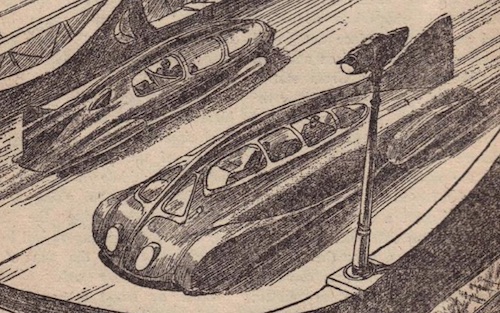Science Fiction
Dictionary
A B C D E F G H I J K L M N O P Q R S T U V W X Y Z
Latest By
Category:
Armor
Artificial
Intelligence
Biology
Clothing
Communication
Computers
Culture
Data Storage
Displays
Engineering
Entertainment
Food
Input Devices
Lifestyle
Living Space
Manufacturing
Material
Media
Medical
Miscellaneous
Robotics
Security
Space Tech
Spacecraft
Surveillance
Transportation
Travel
Vehicle
Virtual
Person
Warfare
Weapon
Work
"Writing about the future, I have a vested interest in there being a future for me to write about."
- John Brunner
| Gyrocars with Photo-Electric Braking | ||
| Force the tires into maximum contact with the road, then use photo-electric sensors to control braking and turns. |
| All that night Bob wrestled with the question — to add weight without inertia. It seemed a paradox, but at the back of his mind he was sure there must be a solution apart from the question of a gravity attractor...
"Don't you see, sir; once you set a heavy wheel spinning, it strongly resists a change in its plane of rotation. Take a gyroscope big enough and fast enough. Couple one side of its cradle to the axle of a car and then, as you apply brakes, increase the length of the coupling arm by any sort of toggle. The gyroscope refuses to change its plane, and so the wheels are forced down by the toggle lever and you get as much friction as the tires will stand!"
 (Gyrocars from 'Photo Control' by Bernard Brown) The greatest problem of all was the elimination of the human element of braking together with its inevitable time lag. It was all very well to design and develop super-efficient brakes, but even they would be of very little use in preventing accidents it put under the control of any Tom, Dick or Harry, who had enough money to buy a car... To tht front two curiously shaped headlamps were placed at the lateral extremities on a complicated swivelling arrangement. Bob noted further that these apparent lamps were twisted slightly inwards and instead of pointing towards the ground were directed straight out. "Actually they are carefully prepared and focussed tele-lenses at the back of each of which is situated one of the new ribidium photo-electric cells." "These are always trained ahead of the car and Inwards to an extent depending on the speed. Actually their mountings are coupled indirectly to the road wheels so that the faster the wheels rotate the lesser is the angle subtended between the two sets of lenses. In other words the faster the car goes the further away is the point of intersection of the two beams." "As the thing stands now photo-electric cells are placed behind the tenses and as soon as any body falls within the zone of safety the photo-cells are affected and, operating on a relay, apply the brakes to the full." |
| Technovelgy from Photo Control,
by Bernard Brown. Published by Amazing Stories in 1934 Additional resources -
|
Comment/Join this discussion ( 0 ) | RSS/XML | Blog This |
Additional
resources:
More Ideas
and Technology from Photo Control
More Ideas
and Technology by Bernard Brown
Tech news articles related to Photo Control
Tech news articles related to works by Bernard Brown
| EVs To Be Made In ICE Detroit-Hamtramck Plant |
| Charging An Electric Car In 2019 (Video), 1912 (Photo) And 1894 (Fiction) |
| China Bans Self-Driving Car Testing |
| Ignition Interlock Devices Stopped 1.7 Million Drunken Tries |
Want to Contribute an
Item?
It's easy:
Get the name of the item, a
quote, the book's name and the author's name, and Add
it here.
| <Previous | Next> |
|
|
|
Technovelgy (that's tech-novel-gee!) is devoted to the creative science inventions and ideas of sf authors. Look for the Invention Category that interests you, the Glossary, the Science Fiction Invention Timeline, or see what's New.
|
Science Fiction
Timeline
1600-1899
1900-1939
1940's 1950's
1960's 1970's
1980's 1990's
2000's 2010's
'The leg was to function, in a way, as a servo-mechanism operated by Larry’s brain...'
'The observation vehicle was of that peculiar variety used in conveying a large number of people across rough terrain.'
'The real border was defended by... a swarm of quasi-independent aerostats.'
'I ... set my automatic astronomical instruments to searching for a habitable planet.'
'...haven't you a section of the factory where only robot labor is employed?'
